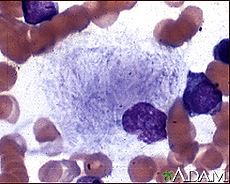 |
 |
 |
Other Health Topics:

-
Related Topics
-
Go Local
- Services and providers for Gaucher's Disease in the U.S.
-
National Institutes of Health
- The primary NIH organization for research on Gaucher's Disease is the National Institute of Neurological Disorders and Stroke
Gaucher's Disease
Gaucher's disease is a rare, inherited disorder that causes too much of a substance called glucocerebroside to build up in your spleen, liver, lungs, bones and sometimes in your brain. The buildup prevents these organs from working properly.
There are three types:
- Type 1, the most common form, causes liver and spleen enlargement, bone pain and broken bones, and, sometimes, lung and kidney problems. It does not involve the brain. It can occur at any age.
- Type 2, which causes severe brain damage, appears in infants. Most children who have it die by age 2.
- In type 3, there may be liver and spleen enlargement, and signs of brain involvement appear gradually.
Gaucher's disease has no cure. Treatment options for types 1 and 3 include medicine and enzyme replacement therapy, which is usually very effective. There is no good treatment for the brain damage of type 2.
National Institute of Neurological Disorders and Stroke
Start Here
-
Gaucher's Disease
 (National Institute of Neurological Disorders and Stroke) - Short Summary
(National Institute of Neurological Disorders and Stroke) - Short Summary
| Basics | Learn More | Multimedia & Cool Tools |
|---|---|---|
|
||
| Research | Reference Shelf | For You |
|
-
Overviews
- Gaucher's Disease(Mayo Foundation for Medical Education and Research)
-
JAMA Patient Page: Gaucher Disease(American Medical Association)
Also available in Spanish
-
Diagnosis/Symptoms
- Gaucher Disease: Diagnosis and Treatment(Center for Jewish Genetic Diseases)
-
Related Issues
-
Lipid Storage Diseases
 (National Institute of Neurological Disorders and Stroke)
(National Institute of Neurological Disorders and Stroke)
Also available in Spanish
-
Lipid Storage Diseases
 (National Institute of Neurological Disorders and Stroke)
(National Institute of Neurological Disorders and Stroke)
-
Researching Disease: Dr. Roscoe Brady and Gaucher Disease
 (National Institutes of Health)
(National Institutes of Health)
-
Lipid Storage Diseases
-
Clinical Trials
-
ClinicalTrials.gov: Gaucher Disease
 (National Institutes of Health)
(National Institutes of Health)
-
ClinicalTrials.gov: Gaucher Disease
-
Genetics
-
Genetics Home Reference: Gaucher disease
 (National Library of Medicine)
(National Library of Medicine)
-
Genetics Home Reference: Gaucher disease
-
Journal Articles
References and abstracts from MEDLINE/PubMed (National Library of Medicine)
- Article: Cognitive outcome in treated patients with chronic neuronopathic Gaucher disease.
- Article: Correlation of MRI-Based bone marrow burden score with genotype and...
- Article: Management of non-neuronopathic Gaucher disease with special reference to pregnancy,...
- Gaucher's Disease -- see more articles
-
Directories
- US Clinic Directory Search(University of Washington)
-
Organizations
- Center for Jewish Genetic Diseases
-
National Institute of Neurological Disorders and Stroke

Also available in Spanish
| Home | Health Topics | Drugs & Supplements | Encyclopedia | Dictionary | News | Directories | Other Resources | |
| Disclaimers | Copyright | Privacy | Accessibility | Quality Guidelines U.S. National Library of Medicine, 8600 Rockville Pike, Bethesda, MD 20894 National Institutes of Health | Department of Health & Human Services |
Date last updated: 13 June 2008 Topic last reviewed: 03 August 2008 |






